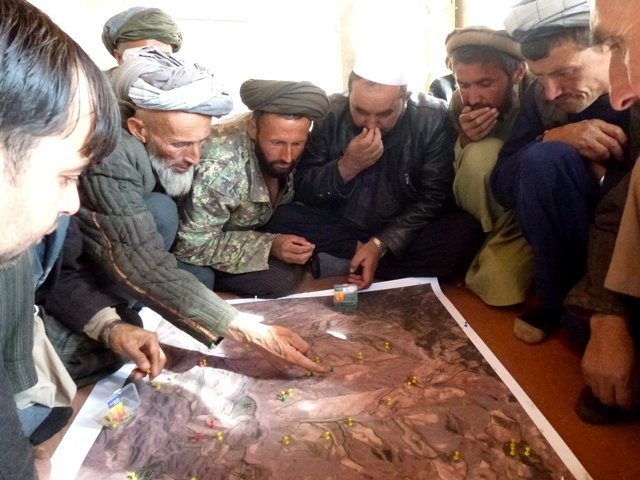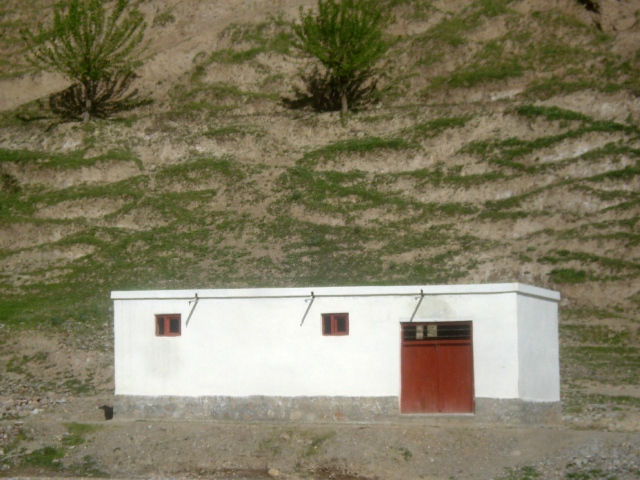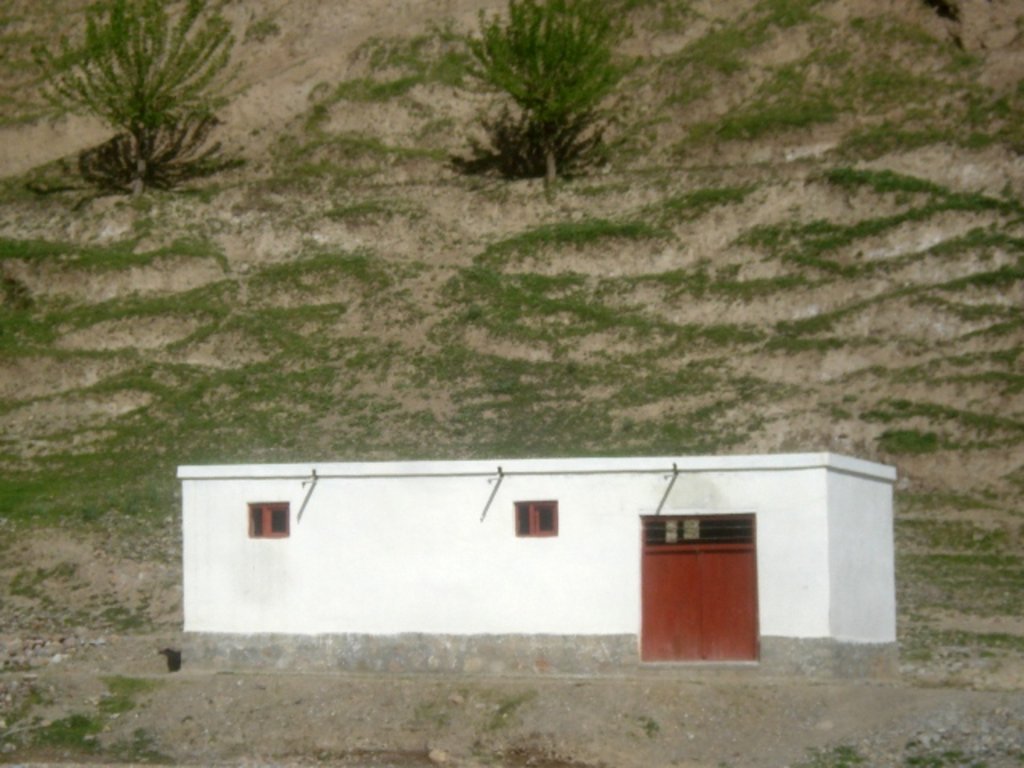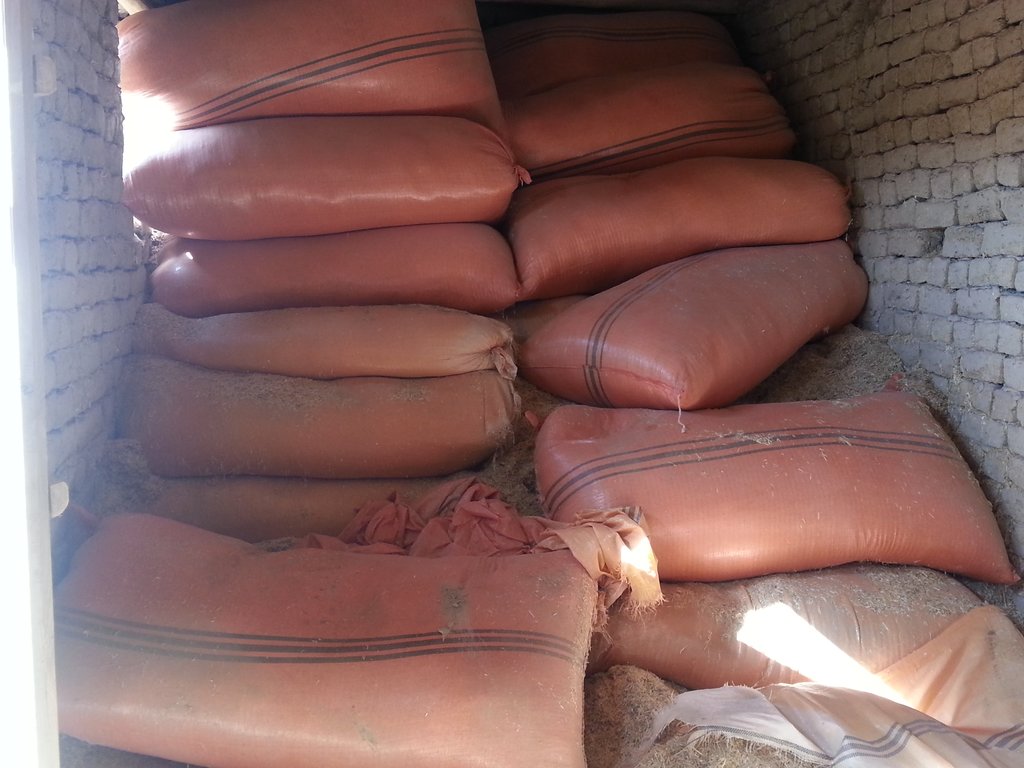Community fodder bank for sustaining supplies [Афганистан]
- Шинийг нээх:
- Шинэчлэх:
- Эмхэтгэгч: Bettina Wolfgramm
- Хянан тохиолдуулагчид: MIAJAN MAROOFI, Hekmatullah Sharifzai, Roziya Kirgizbekova, Aslam Qadamov
- Хянагч: William Critchley
Kahdon; Somonkhona
technologies_674 - Афганистан
Бүлгүүдийг үзэх
Бүгдийг дэлгэх Бүгдийг хаах1. Ерөнхий мэдээлэл
1.2 Технологийг үнэлэх, баримтжуулах ажилд хамаарах мэдээлэл өгсөн хүмүүс, байгууллагуудын холбоо барих мэдээлэл
Мэдээлэл өгсөн хүн (с)
Газар ашиглагч:
Mohammad Azim Habibullah
Natural Resources Management Committee (NRMC)
Sari Joy village, Rustaq District
Афганистан
ГТМ мэргэжилтэн:
Researcher:
Технологи баримтжуулах/үнэлэх ажилд дэмжлэг үзүүлсэн төслийн нэр (шаардлагатай бол)
Livelihood Improvement Project Takhar, Afghanistan (LIPT)Технологи баримтжуулах/үнэлэх ажилд дэмжлэг үзүүлсэн төслийн нэр (шаардлагатай бол)
Potential and limitations for improved natural resource management (NRM) in mountain communities in the Rustaq district, Afghanistan (Rustaq NRM Study)Технологи баримтжуулах/үнэлэх ажилд дэмжлэг үзүүлсэн байгууллага(ууд)-ын нэр (шаардлагатай бол)
Terre des Hommes (Terre des Hommes) - ШвейцарТехнологи баримтжуулах/үнэлэх ажилд дэмжлэг үзүүлсэн байгууллага(ууд)-ын нэр (шаардлагатай бол)
Swiss Agency for Development and Cooperation (DEZA / COSUDE / DDC / SDC) - ШвейцарТехнологи баримтжуулах/үнэлэх ажилд дэмжлэг үзүүлсэн байгууллага(ууд)-ын нэр (шаардлагатай бол)
CDE Centre for Development and Environment (CDE Centre for Development and Environment) - Швейцар1.3 ВОКАТ-аар баримтжуулсан өгөгдлийг ашиглахтай холбоотой нөхцөл
Мэдээллийг хэзээ (газар дээр нь) цуглуулсан бэ?
17/10/2016
Эмхэтгэгч болон гол мэдээлэгч хүн(хүмүүс) WOCAT аргачлалаар баримтжуулсан мэдээллийг ашиглахтай холбоотой нөхцлийг хүлээн зөвшөөрсөн:
Тийм
1.4 Технологи тогтвортой гэдгийг баталгаажуулах
Энэ технологийг газрын доройтлыг бууруулж, газрын тогтвортой менежментийг хангахад тохиромжтой гэж үзэж болох уу?
Үгүй
Тайлбар:
SLM practices documented in the framework of the Rustaq NRM study were established only recently (1-3 years ago). It is too early for a final judgment on the sustainability of these technologies within the human and natural environment of Chokar watershed.
1.5 ГТМ-ийн Арга барилын талаархи санал асуулгын(д) суурь мэдээлэл

Watershed Associations (WSA) and Natural Resource Management Committees … [Афганистан]
Two Watershed Associations (WSA), in Chaker and Nahristan watershed areas respectively, are registered at the national level with the Ministry of Agriculture Irrigation and Livestock (MAIL) and at the regional level with the Department of Agriculture. Both associations are strong, active, dynamic, and have the capacity to coordinate and support …
- Эмхэтгэгч: Bettina Wolfgramm
2. ГТМ Технологийн тодорхойлолт
2.1 Технологийн товч тодорхойлолт
Технологийн тодорхойлолт:
Community fodder banks have been established in villages for the purpose of ensuring supplies of livestock fodder during winter, to prevent loss of livestock and to prevent over-grazing early in spring.
2.2 Технологийн дэлгэрэнгүй тодорхойлолт
Тодорхойлолт:
Livestock keeping is one of the key livelihood strategies in rural Rustaq, in addition to cultivation of agricultural crops. Families rely on their livestock not only for consumption of meat and dairy products, but also as means of transportation (donkeys), labour force in agriculture (oxen, donkeys) and a source of cash income. When crops fail to produce enough, families sell their livestock to survive until the next season. Naturally, every family strives to increase their household’s livestock as much as they can, which increases pressure on the local pastures, leading to extensive overgrazing.
The pastures in Jawaz Khana, Dashti Mirzai and Sari Joy are characterized by poor vegetation cover, low carrying capacity and severe erosion - with deep rills clearly visible. The quantity and quality of fodder is insufficient for all the livestock, leading to poor animal health. Starting from early spring to late autumn livestock keepers graze their animals on the open grazing lands. During winter months, the animals are kept inside and fed with the fodder conserved during summer. Very often, and especially during droughts, the fodder stocks can be extremely low and inadequate for the animals to make it through to spring - and then farmers lose livestock.
For the purpose of tackling fodder shortages during winter months and preventing livestock loss, the Livelihood Improvement Project in Takhar (LIPT) supported the Natural Resources Management Committees in Sari Joy, Dashti Mirzai and Jawaz Khana to establish community fodder banks. The fodder bank is also meant to compensate for the closure of rehabilitated pastures during the exclusion period of 1-3 years.
The NRMC mobilized the community to construct the fodder bank building. The building is composed of a large single space of 3.5 m x 10 m x 4 m. Generally the location for the fodder bank is chosen in the middle of the village near the mosque or NRMC building. On average, the fodder bank has a capacity of 250 bags of straw and 50 bundles of hay. Durable construction materials, namely stone and cement are used for the walls. The walls are painted for protection from mould. Proper windows and entrance door are installed to ensure insulation and protection from weather events. The construction materials and labour costs are fully covered by the LIPT project. The maintenance works for the building consists of repairing the roof every autumn with a clay layer.
The fodder bank serves as a reserve for the village community. After each harvest the farmers deliver a certain amount of fodder to the fodder bank, and in return they can take out fodder for their livestock needs. The established regulations require that each farmer is obliged to reimburse the fodder bank for the fodder he has taken as a loan. The NRMC appoints persons in charge of accepting, and releasing, fodder from the fodder bank. The persons in charge record the incoming and outgoing fodder in the log book for fodder. The log book registers the name of the farmer and the amount of fodder he has delivered, or taken, from the fodder bank.
The fodder banks have been functioning for only couple of years. The community has been using the fodder bank to feed their livestock during winter mainly, but also when they have shortage of fodder in other months as well. Due to the low capacity of current pastures the farmers produce just enough to feed their livestock and not much is left to store in the fodder bank. The fodder stocks are expected to increase in future as part of the ongoing process of pasture rehabilitation through cultivation of alfalfa and rotational grazing plans.
Women and children are often involved in collecting the hay and carrying it to the fodder bank. This requires long-distance walks with heavy loads since many houses are located far from the fodder bank. Despite this heavy work, women say that they find the fodder banks useful because of the opportunity to borrow hay for their livestock when they need it.
2.3 Технологийн гэрэл зураг
2.5 Энэ үнэлгээнд хамрагдсан технологийг хэрэгжүүлсэн улс орон/ бүс нутаг/ байршил
Улс:
Афганистан
Улс/аймаг/сум:
Takhar Province, Rustaq District
Байршлын дэлгэрэнгүй тодорхойлолт:
Dashti Mirzai, Sari Joy, Jawaz Khana Villages
Тайлбар:
Coordinates of SLM plots owned by SLM implementers who participated in the FGD derived through the Rustaq NRM study QGIS database.
This documentation is based on the experiences of SLM implementers from Sari Joy (1 Fodder bank), Jawaz Khana, (1 Fodder bank), and Dashti Mirzai (1 Fodder bank).
Map
×2.6 Хэрэгжсэн хугацаа
Хэрэгжүүлсэн он:
2014
Байгуулсан тодорхой оныг мэдэхгүй бол баримжаа хугацааг тодорхойл:
- <10 жилийн өмнө (саяхны)
2.7 Технологийн танилцуулга
Технологийг хэрхэн нэвтрүүлснийг тодорхойл:
- Гадны төсөл/хөтөлбөрийн дэмжлэгтэйгээр
Тайлбар (төслийн төрөл г.м.):
Livelihood Improvement Project Takhar (LIPT) supported by Swiss Development Cooperation (SDC) from 2012-17
3. ГТМ технологийн ангилал
3.1 Технологийн үндсэн зорилго (ууд)
- газрын доройтлыг бууруулах, сэргийлэх, нөхөн сэргээх
- Improve fodder supplies
3.2 Технологи нэвтрүүлсэн газрын одоогийн газар ашиглалтын хэлбэр(үүд)

Суурьшил, дэд бүтэц
- Хот суурин, барилга
Нэмэлт мэдээлэл:
Fodder bank to store hay and wheat straw
3.3 Газар ашиглалтын тухай нэмэлт мэдээлэл
Технологи хэрэгжүүлсэн газрын усан хангамж:
- Байгалийн усалгаатай
Жилд ургамал ургах улирлын тоо:
- 1
3.4 Технологи ГТМ-ийн аль бүлэгт хамаарах вэ
- Бэлчээрийн мал аж ахуй ба бэлчээрийн газрын менежмент
- Ургац хураалтын дараах арга хэмжээ
3.5 Технологийн хамрах талбай
Технологи өргөн дэлгэрсэн эсхийг тодорхойл:
- тодорхой газар хэрэгжсэн/ жижиг талбайд төвлөрсөн
3.6 Технологийг бүрдүүлэх ГТМ арга хэмжээ

бусад арга хэмжээ
Тайлбар:
The measures comprise construction of a facility to host community fodder bank
3.8 Газрын доройтлоос урьдчилан сэргийлэх, сааруулах ба нөхөн сэргээх
Газрын доройтолтой холбоотойгоор Технологи ямар зорилго тавьсан болохыг тодорхойл:
- Хүчтэй доройтсон газрыг нөхөн сэргээх/ сайжруулах
Тайлбар:
The Technology is implemented in support of pasture rehabilitation, sustaining fodder for livestock and preventing early grazing, .
4. Техникийн нөхцөл, хэрэгжүүлсэн үйл ажиллагаа, материал ба зардал
4.2 Техникийн үзүүлэлт/ техникийн зургийн тайлбар
The building is composed of a large single room of 3.5 m x 10 m x 4 m. Generally the location for the fodder bank is chosen in the middle of the village near the mosque or NRMC building. On average, the fodder bank has a capacity of 250 bags of straw and 50 bundles of hay. Durable construction materials such as stone and cement are used for the walls. The walls are covered with white paint for protection from mould. Proper windows and entrance door are installed to ensure insulation and protection from weather events. The construction materials and labour costs are fully covered by the LIPT project. The maintenance works consists of repairing the roof every autumn with a clay layer.
4.3 Материал болон зардалд хамаарах ерөнхий мэдээлэл
Үнэ өртөг, оруулсан хувь нэмрийг хэрхэн тооцсоныг тодорхойл:
- Технологийн нэгж тус бүр
Нэгжийг тодорхойл:
Building
Эзэлхүүн, урт зэргийг тодорхойл (тохиромжтой бол):
Measurements: 3.5 m x10 m x 4 m
Үнэ өртөгийг тооцоход ашигласан мөнгөн нэгж:
- Америк доллар
Ам.доллар ба үндэсний мөнгөн нэгж хоорондын хөрвөх үнийг тодорхойл (шаардлагатай бол): 1 USD =:
67.0
Хөлсний ажилчны нэг өдрийн цалингийн хэмжээг тодорхойлно уу:
5.2-5.3 USD
4.4 Бий болгох үйл ажиллагаа
| Үйл ажиллагаа | Арга хэмжээний төрөл | Хугацаа | |
|---|---|---|---|
| 1. | Selection of the site for building the fodder bank | Менежментийн | Spring |
| 2. | Preparatory works and excavation of the site | Барилга байгууламжийн | Summer |
| 3. | Construction of walls | Барилга байгууламжийн | Summer |
| 4. | Other construction works and installations | Барилга байгууламжийн | Summer |
4.5 Бий болгоход шаардагдсан зардал, хөрөнгийн өртөг
| Зардлын нэр, төрөл | Хэмжих нэгж | Тоо хэмжээ | Нэгжийн үнэ | Зардал бүрийн нийт өртөг | Нийт дүнгээс газар ашиглагчийн төлсөн % | |
|---|---|---|---|---|---|---|
| Хөдөлмөр эрхлэлт | Preparatory works and excavation of the site | person-day | 2.0 | 5.3 | 10.6 | |
| Хөдөлмөр эрхлэлт | Construction of wall of the facility | person-day | 15.0 | 5.3 | 79.5 | |
| Хөдөлмөр эрхлэлт | Other construction works and installations | person-day | 15.0 | 5.3 | 79.5 | |
| Тоног төхөөрөмж | Hummer | piece | 2.0 | 3.7 | 7.4 | |
| Тоног төхөөрөмж | Weel barrow | piece | 1.0 | 37.0 | 37.0 | |
| Тоног төхөөрөмж | Pickaxe | piece | 2.0 | 3.7 | 7.4 | |
| Тоног төхөөрөмж | Big hammer | piece | 1.0 | 13.0 | 13.0 | |
| Тоног төхөөрөмж | Saw | piece | 1.0 | 2.8 | 2.8 | |
| Тоног төхөөрөмж | Shovel | piece | 4.0 | 3.7 | 14.8 | |
| Тоног төхөөрөмж | Gloves | set | 10.0 | 1.5 | 15.0 | |
| Тоног төхөөрөмж | Other tools | piece | 10.0 | 3.2 | 32.0 | |
| Барилгын материал | Stone for construction | cubic meter | 12.0 | 16.0 | 192.0 | |
| Барилгын материал | Cement | Bag | 71.0 | 3.7 | 262.7 | |
| Барилгын материал | Lime | kg | 1.0 | 14.0 | 14.0 | |
| Барилгын материал | Gravel | cubic meter | 4.0 | 16.0 | 64.0 | |
| Барилгын материал | Oil paint | kg | 10.0 | 1.7 | 17.0 | |
| Барилгын материал | Door | piece | 1.0 | 162.0 | 162.0 | |
| Барилгын материал | Window | piece | 4.0 | 17.0 | 68.0 | |
| Барилгын материал | Plastic color 50% and 100% | kg | 48.0 | 2.45 | 117.6 | |
| Технологи бий болгох нийт үнэ өртөг | 1196.3 | |||||
Хэрэв газар ашиглагч нийт зардлын 100% -иас бага хэсгийг төлсөн бол хэн голлох зардлыг гаргасан бэ:
Livelihood Improvement Project Takhar (LIPT) implemented by Terre des hommes (Tdh) Switzerland
4.6 Арчилгаа/ урсгал үйл ажиллагаа
| Үйл ажиллагаа | Арга хэмжээний төрөл | Хугацаа/ давтамж | |
|---|---|---|---|
| 1. | Repair works of the roof with clay and hay mixture | Барилга байгууламжийн | Autumn |
4.7 Арчилгаа/урсгал ажилд шаардагдсан зардал, хөрөнгийн өртөг (нэг жилд)
| Зардлын нэр, төрөл | Хэмжих нэгж | Тоо хэмжээ | Нэгжийн үнэ | Зардал бүрийн нийт өртөг | Нийт дүнгээс газар ашиглагчийн төлсөн % | |
|---|---|---|---|---|---|---|
| Хөдөлмөр эрхлэлт | Repair of the roof | person day | 2.0 | 5.3 | 10.6 | 100.0 |
| Технологийн арчилгаа/урсгал үйл ажиллагаанд шаардагдах нийт үнэ өртөг | 10.6 | |||||
4.8 Зардалд нөлөөлж байгаа хамгийн чухал хүчин зүйл
Өртөг, зардалд нөлөөлөх гол хүчин зүйл:
Due to the remoteness of the villages where the Technology has been implemented, all the inputs for establishment, such as agricultural equipment, plant material, fertilizers, etc., are purchased in Rustaq town. The expenses for traveling and delivering the inputs affect the establishment costs.
5. Байгаль ба нийгмийн нөхцөл
5.1 Уур амьсгал
Жилийн нийлбэр хур тундас
- < 250 мм
- 251-500 мм
- 501-750 мм
- 751-1,000 мм
- 1,001-1,500 мм
- 1,501-2,000 мм
- 2,001-3,000 мм
- 3,001-4,000 мм
- > 4,000 мм
Жилийн дундаж хур тунадас (хэрэв мэдэгдэж байвал), мм:
580.00
Хур тунадасны талаархи тодорхойлолт/ тайлбар:
Average annual precipitation for the area was calculated with 580 mm, with minimum in dry years (2000 and 2001) of 270 mm and maximum in wet years (2009/2010) of 830 mm. The absolute maximum rainfall was calculated for 1986 with 1024 mm. The data series covers the time from 1979 to 2014
Холбогдох цаг уурын станцын нэр:
Reference meteorological station considered: Climate Forecast System Reanalysis (CFSR), http://rda.ucar.edu/pub/cfsr.html
Агро-уур амьсгалын бүс
- хагас хуурай
Derived from the publicly available data set on length of growing period (LGP) (Fischer 2009 / IIASA-FAO). Internet link: http://tiles.arcgis.com/tiles/P8Cok4qAP1sTVE59/arcgis/rest/services/Length_of_growing_period/MapServer
5.4 Усны хүртээмж ба чанар
Гүний усны түвшин:
5-50 м
Гадаргын усны хүртээмж:
дунд зэрэг
Усны чанар (цэвэршүүлээгүй):
сайн чанарын ундны ус
Усны давсжилтын асуудал бий юу?
Үгүй
Энэ газар үерт автдаг уу?
Тийм
Тогтмол байдал:
тохиолдлын
Усны чанар, нөөцийн талаархи тайлбар ба бусад тодорхойлолт:
Floods occur mainly during the rainy seasons in spring and autumn. Availability of surface water differs for the three study villages Sari Joy, Jawaz Khana, and Dashti Mirzai. Sari Joy has sources and good surface water availability. Jawaz Khana has poor water availability as water has to be fetched from a lower-down stream. Dashti Mirzai has good water availability - also from an irrigation channel.
5.5 Биологийн олон янз байдал
Зүйлийн олон янз байдал:
- Бага
Амьдрах орчны олон янз байдал:
- Бага
5.6 Технологи нэвтрүүлсэн газар ашиглагчдын тухай мэдээлэл
Суурьшмал эсвэл нүүдлийн:
- Хагас-нүүдэлийн
Үйлдвэрлэлийн системийн зах зээлийн чиг баримжаа:
- амь зуух арга хэлбэрийн (өөрийгөө хангах)
- холимог (амь зуух/ худалдаа наймаа
Бусад эх үүсвэрээс олох орлого:
- Нийт орлогын 10-50 %
Чинээлэг байдлын түвшин:
- ядуу
- дундаж
Хувь хүн эсвэл бүлэг:
- Хувь хүн / өрх
- бүлэг / олон нийтийн
Механикжилтын түвшин:
- гар ажил
- ердийн хөсөг
Хүйс:
- эмэгтэй
- эрэгтэй
Газар ашиглагчийн нас:
- дунд нас
Газар ашиглагчдын бусад шинж чанарыг тодорхойл:
The land users in the area where the Technology is applied belong to the Uzbek ethnic minority group Qarluq.
Although the men are generally the main land users, however, women and children also take active part in the related work. The functions of men and women are clearly distinguished within the Afghan society. At the same time within the family this division of work and functions also results in men and women working hand-in-hand. An improvement of the family’s livelihood situation is expected to positively affect all family members. While, it is recognized that the involvement of women is key in order to secure basic human rights for everyone, to achieve good governance, sustainable development, and to efficiently contribute to poverty reduction (SDC 2004), it is also clear that a context sensitive approach is of great importance.
Women in rural Afghanistan are involved in many production and income generating activities that contribute to the overall household income, however, very few women own resources such as land and livestock, and their income generating options are fewer in comparison to that of men.
5.7 Технологи нэвтрүүлсэн газар ашиглагчийн өмчилж буй, эзэмшиж буй, түрээсэлж буй эсвэл ашиглаж буй (ашиглах эрх) газрын талбай
- < 0.5 га
- 0.5-1 га
- 1-2 га
- 2-5 га
- 5-15 га
- 15-50 га
- 50-100 га
- 100-500 га
- 500-1,000 га
- 1,000-10,000 га
- > 10,000 га
Энэ талбай том, жижиг, дунд алинд хамаарах вэ (орон нутгийн нөхцөлд харгалзуулна уу)?
- дунд-хэмжээний
5.8 Газар эзэмшил, газар ашиглах эрх, ус ашиглах эрх
Газар өмчлөл:
- нэгдлийн/ тосгон
- хувь хүн, өмчийн гэрчилгээгүй
Газар ашиглах эрх:
- нэгдлийн хэлбэрээр (зохион байгуулалттай)
- хувь хүн
Ус ашиглах эрх:
- нэгдлийн хэлбэрээр (зохион байгуулалттай)
Тайлбар:
Those who own land and use water for irrigation are obliged to pay for water. The payment is made both in kind and in cash to the Mirob - the person in charge of distributing water in the community. The amount of the payment varies from village to village.
5.9 Дэд бүтэц, үйлчилгээний хүртээмж
эрүүл мэнд:
- ядуу
- дунд зэргийн
- сайн
боловсрол:
- ядуу
- дунд зэргийн
- сайн
техник зөвлөгөө:
- ядуу
- дунд зэргийн
- сайн
хөдөлмөр эрхлэлт (жишээ нь, ХАА-аас өөр):
- ядуу
- дунд зэргийн
- сайн
зах зээл:
- ядуу
- дунд зэргийн
- сайн
эрчим хүчний хангамж:
- ядуу
- дунд зэргийн
- сайн
зам тээвэр:
- ядуу
- дунд зэргийн
- сайн
усан хангамж ба ариутгал:
- ядуу
- дунд зэргийн
- сайн
санхүүгийн үйлчилгээ:
- ядуу
- дунд зэргийн
- сайн
6. Үр нөлөө ба дүгнэлт
6.1 Технологийн талбайд үзүүлсэн нөлөө
Нийгэм-соёлын үр нөлөө
ГТМ/ газрын доройтлын мэдлэг
Тайлбар/ тодорхой дурьдах:
Land users learned about the SLM practice through involvement in the process.
6.2 Технологийн талбайн гадна үзүүлсэн үр нөлөө
Нөлөөллийн үнэлгээнд хамаарах нэмэлт тайлбар:
These comments apply to 6.1 and 6.2:
- Socio-economic impacts: Individual SLM implementers were asked to rate the benefits from the Technology. They were asked to indicate production increase of crops; fodder; animals; wood; non-wood forest products; increase in product diversity; or production area. The most important increase they rated with 3, the second most with 2, others with 1 point. Averages of the points given by all implementers are reflected here.
- Similarly for the "ecological impacts" and on "off-site impacts": Individual SLM implementers were asked to rate the on-site and off-site impacts of the Technology on water; soil; and vegetation. They were asked to indicate the strength of impacts with three, two or one points. Averages of the points given by all Technology implementers are reflected here.
- Socio-cultural impacts: This section is answered by the scientists, based on information collected during focus group discussions, and interviews conducted with persons from the 3 villages where the LIPT project implemented the Technology.
6.3 Технологийн уур амьсгалын өөрчлөлт, цаг агаарын гамшигт үзэгдэлд өртөх байдал ба эмзэг байдал (газар ашиглагчийн бодлоор)
Тайлбар:
SLM implementers from three villages were asked to jointly discuss and rate how much the SLM technology reduced the lands vulnerability to drought and local rainstorms. Only vulnerability to the most prevalent climate extremes (drought and local rainstorms) was discussed. SLM technologies were rated as reducing vulnerability poorly , well, or very well. The average points reflected here are from multi-criteria matrices compiled in three villages where the SLM technology had been implemented.
6.4 Өртөг ба ашгийн шинжилгээ
Бий болгох зардалтай харьцуулахад ямар ашиг өгсөн бэ (газар ашиглагчийн бодлоор)?
Богино хугацаанд эргэн төлөгдөх байдал:
маш эерэг
Урт хугацаанд эргэн төлөгдөх байдал:
маш эерэг
Тайлбар:
Based on the multi-criteria matrix: During the FGD with SLM implementers, a multi-criteria matrix was elaborated, and different SLM practices were rated. In the framework of this exercise, SLM implementers were asked to jointly discuss and rate short term (1-3 years) and long-term (10 years) returns. As the SLM technology was only implemented 1-2 years ago, it is too early to compare benefits to maintenance costs. Farmers have little experience so far on the actual benefits of the SLM technology. The ratings are mostly based on expected benefits and not on actual benefits.
6.5 Технологи нэвтрүүлэлт
- жишээ/ туршилт
Тайлбар:
One fodder bank is established in each village to be used by the whole community for storing their hay.
6.6 Дасан зохицох
Бий болсон өөрчлөлтөд зохицуулан технологийг өөрчилсөн үү?
Үгүй
6.7 Технологийн давуу тал/боломжууд
| Газар ашиглагчдын тодорхойлсон давуу тал/боломжууд |
|---|
| Fodder reserves are available during winter and early spring. |
| Livestock keepers can borrow fodder from the fodder bank when they need it. |
| The fodder is stored in a dry place and is protected from rain and snow. |
| Эмхэтгэгч, бусад мэдээлэл өгсөн хүмүүсийн өнцгөөс тодорхойлсон давуу тал/боломжууд |
|---|
| The community learns how to regulate the use of fodder |
| By providing fodder reserves, the rehabilitated pastures are protected from early grazing in spring. |
6.8 Технологийн дутагдалтай/сул тал/аюул болон тэдгээрийг хэрхэн даван туулах арга зам
| Эмхэтгэгч, бусад мэдээлэл өгсөн хүмүүсийн өнцгөөс тодорхойлсон сул тал/ дутагдал/ эрсдэл | Тэдгээрийг хэрхэн даван туулах вэ? |
|---|---|
| Poor awareness and community participation in storing their fodder in the fodder banks | More community awareness and mobilization |
7. Ном зүй ба холбоосууд
7.1 Мэдээлэл цуглуулсан арга/эх үүсвэр
- Газар ашиглагчтай хийсэн ярилцлага
Focus group discussions (FGD) were organized to collect information from SLM implementers in the villages of Sari Joy, Jawaz Khana and Dashti Mirzai.
- ГТМ-ийн мэргэжилтэн/шинжээчтэй хийсэн ярилцлага
Close collaboration took place during the compilation of this material with the technical staff of the LIPT project in Rustaq.
- тайлан болон бусад эх сурвалжийн бүрдэл
Information provided in the reports of Tdh LIPT Project in Rustaq served as an initial source of information during the preparatory phase and also solidifying the description of the technology and area of implementation. Other background papers on Afghanistan were referred to for general information on agriculture and natural resource management in Afghanistan.
7.2 Ном, хэвлэлийн ишлэл
Гарчиг, зохиогч, он, ISBN:
Guidelines for Focus Groups Discussions
Гарчиг, зохиогч, он, ISBN:
Methods section of the Rustaq NRM study
Холбоос ба модулууд
Бүгдийг дэлгэх Бүгдийг хаахХолбоосууд

Watershed Associations (WSA) and Natural Resource Management Committees … [Афганистан]
Two Watershed Associations (WSA), in Chaker and Nahristan watershed areas respectively, are registered at the national level with the Ministry of Agriculture Irrigation and Livestock (MAIL) and at the regional level with the Department of Agriculture. Both associations are strong, active, dynamic, and have the capacity to coordinate and support …
- Эмхэтгэгч: Bettina Wolfgramm
Модулууд
Модуль байхгүй байна





